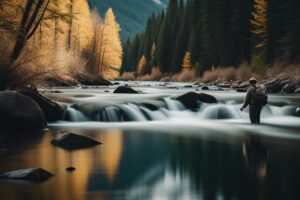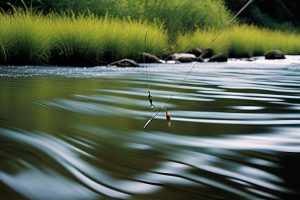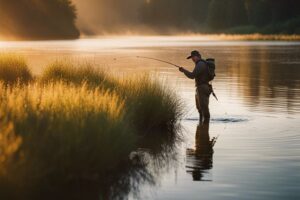Tips from an experienced fly fisherman can take your angling game to the next level. In this blog post, you will explore into the insights and advice from a seasoned pro in the world of fly fishing. Learn from their wisdom and sharpen your skills on the water. Time to reel in those big catches with expert guidance!
Key Takeaways:
- Understanding the Basics: A key aspect of successful fly fishing is understanding the behavior of the fish and their feeding patterns.
- Importance of Technique: Proper casting technique is crucial for a successful day on the water. Practicing casting in different conditions can greatly improve your skills.
- Choosing the Right Flies: Matching the hatch is necessary. It’s important to have a variety of fly patterns in your tackle box to adapt to changing conditions.
- Location Matters: Knowing where to find fish is necessary. Experienced fly fishermen recommend exploring different waters and talking to locals for insider tips.
- Patience and Persistence: Fly fishing requires patience and persistence. It’s important to observe and adapt to the conditions to increase your chances of catching fish.
- Respect for nature: Fly fishermen emphasize the importance of conservation and leaving no trace when out on the water. Respecting the environment ensures the sustainability of the sport for future generations.
- Continuous Learning: Even seasoned fly fishermen acknowledge that there is always more to learn. Attending workshops, reading books, and watching instructional videos can help improve your skills and knowledge.
The Expert’s Background
Early Days of Fly Fishing
To become a seasoned fly fisherman like yourself, one must start with a passion for the sport from a young age. You likely spent countless hours as a child exploring rivers, studying fish behavior, and perfecting your casting technique. The early days of fly fishing set the foundation for your expertise and deep connection to the sport.
Years of Experience and Notable Catches
Days turned into years, and your dedication to fly fishing only grew stronger. With each outing, you honed your skills, learned the intricacies of different fly patterns, and explored new fishing grounds. Your years of experience have led to numerous notable catches, stories of epic battles with trophy fish, and the admiration of fellow anglers who look up to you as a true master of the craft.
A seasoned fly fisherman like yourself has likely landed impressive catches that have become the stuff of legend within the fly fishing community. Your ability to read the water, understand fish behavior, and select the perfect fly for the conditions sets you apart as an expert angler. With each new catch, you continue to push the boundaries of what is possible in the sport of fly fishing.
Essential Gear and Equipment
If you’re looking to enhance your fly fishing skills, it’s crucial to have the right gear and equipment. For more in-depth tips on selecting the best gear, check out this FLY FISHING TIPS FROM THE PRO’S video playlist.
Rods and Reels: Choosing the Right Combo
On your fly fishing journey, selecting the perfect rod and reel combo is vital. Experienced fly fisherman often recommend starting with a versatile setup that can handle various water conditions and fish species. Consider the weight of the rod and reel, matching them to the type of fish you plan to target. A balanced combo will improve your casting accuracy and overall performance on the water.
Flies: Patterns, Materials, and Presentation
Patterns are crucial in fly fishing, as they mimic different insects and baitfish that fish feed on. When opting for flies, consider the specific species you’re targeting, the water conditions, and the time of year. Experiment with various patterns and materials to see what works best in different situations. Presentation is key – focus on casting accuracy, drift, and mimicking natural movement to entice fish to strike.
It’s vital to understand the importance of flies in fly fishing. The right fly pattern can make all the difference in attracting fish and getting them to bite. Experiment with different fly designs, sizes, and colors to match the natural prey in the water you are fishing in. Do not forget, presentation is key – a precise cast and natural drift can make even the most simple fly pattern irresistible to fish.
Waders and Boots: Staying Comfortable and Dry
Staying comfortable and dry while fly fishing is crucial for a successful day on the water. Invest in quality waders and boots that provide protection from the elements and keep you comfortable throughout your fishing trip. Look for breathable materials that offer insulation and durability. Proper fitting waders and boots will enable you to navigate the water with ease and focus on your fishing without distractions.
Choosing the right waders and boots is vital to your comfort and enjoyment while fly fishing. Look for waders with reinforced seams and waterproof zippers to keep you dry in various water conditions. Boots with sturdy soles and ankle support will help you navigate slippery river rocks and rough terrain with confidence. Prioritize comfort and functionality when selecting your wading gear to ensure a successful and enjoyable fishing experience.
Reading the Water
Unlike traditional fishing, fly fishing requires a keen eye for reading the water in order to effectively target fish. To gain some valuable insights into this skill, I recommend checking out the Professional’s Corner – Interviews with Fly Fishing Guides. Experienced fly fishermen have shared their tips and strategies on how to read the water like a pro.
Identifying Fish Habitats and Structures
Identifying fish habitats and structures is crucial in fly fishing. Look for areas with cover, such as rocks, logs, and overhanging vegetation, as these provide shelter for fish. Pay attention to water depth and temperature, as well as any signs of baitfish or insect activity, which can attract larger fish.
Understanding Currents and Water Flow
For successful fly fishing, it’s important to understand how currents and water flow influence fish behavior. Different species of fish prefer different water speeds and depths, so watch for eddies, seams, and riffles where fish are likely to be feeding. By adjusting your presentation to match the current, you can increase your chances of enticing a strike.
Another important aspect of understanding currents is knowing how to position yourself in relation to the fish. By studying the flow of the water, you can position yourself upstream or downstream to present your fly in a natural manner and avoid spooking the fish.
Spotting Fish Behavior and Activity
To improve your success in fly fishing, you must be able to spot fish behavior and activity. Look for subtle signs like surface disturbances, rising fish, or feeding patterns to locate active fish. By observing their behavior, you can choose the right fly pattern and presentation technique to trigger a strike.
Reading the water is a skill that takes time and practice to develop, but with patience and persistence, you can become adept at deciphering the clues that nature provides and ultimately catching more fish.
Casting Techniques and Strategies
Mastering the Basic Cast
All great fly fishermen started with mastering the basic cast. Techniques such as timing, acceleration, and line control are important to ensure a successful cast. Remember to keep a relaxed grip on the rod, and use a smooth, fluid motion to propel the line forward. Practice makes perfect, so spend time perfecting your basic cast before moving on to more advanced techniques.
Advanced Techniques: Mending, Hauling, and Tucking
Hauling, mending, and tucking are advanced techniques that can help you improve your accuracy and presentation on the water. When hauling, use your non-rod hand to pull on the line during the casting stroke, generating more line speed and distance. Mending involves manipulating the line on the water to adjust the drift of your fly, ensuring a natural presentation. Tucking is a technique used to place the fly softly on the water, mimicking the gentle landing of an insect.
- Hauling: Use your non-rod hand to pull on the line during the casting stroke.
- Mending: Manipulate the line on the water to adjust the drift of your fly.
- Tucking: Gently place the fly on the water to mimic the landing of an insect.
Adapting to Different Fishing Conditions
Casting techniques need to vary depending on the fishing conditions you encounter. The size of the river, wind conditions, and obstacles like trees and rocks can all impact your casting strategy. Remember to adjust your casting angle, timing, and power based on these factors to maximize your chances of a successful catch. By adapting your techniques to different fishing conditions, you can become a more versatile and successful fly fisherman.
Fly Selection and Presentation
Many seasoned fly fisherman will tell you that one of the most critical aspects of successful fly fishing is matching the hatch and choosing the right fly. The ability to observe the insects on the water and select a fly that closely resembles them is key to enticing those elusive trout. Pay attention to the size, shape, and color of the insects around you, and select a fly that mimics them to increase your chances of a bite.
Matching the Hatch: Choosing the Right Fly
The key to effective fly selection lies in observing the insects present in the water and choosing a fly that closely imitates them. The trout are accustomed to feeding on specific types of insects, so presenting them with a fly that matches what they are already eating greatly increases your chances of a successful catch.
Presentation Techniques: Dry Fly, Nymph, and Streamer
Choosing the right presentation technique is crucial in fly fishing. Whether you are using a dry fly, nymph, or streamer, each technique requires a different approach to mimic the natural behavior of the insects in the water.
Techniques such as dry fly fishing involve delicately presenting the fly on the water’s surface to imitate an insect landing. Nymph fishing requires a different approach, as you must mimic the movement of underwater insects by drifting the fly at the same speed as the current. Streamer fishing involves using larger, more colorful flies to imitate baitfish and trigger a predatory response from the trout.
Varying Retrieval Speeds and Actions
To effectively trigger a strike, you must vary your retrieval speeds and actions when fishing with streamers. By experimenting with different retrieval speeds, pauses, and jerky movements, you can make your fly appear more lifelike and enticing to the trout.
This level of control over your fly’s movement can make all the difference in enticing a strike from a wary fish. Remember to stay observant of the trout’s behavior and be willing to adapt your retrieval technique to match their activity level.
Common Mistakes and Troubleshooting
Avoiding Common Errors in Casting and Presentation
Not paying attention to your casting technique can lead to frustrating results when fly fishing. For instance, using too much force in your cast can cause your fly to splash down rather than delicately land on the water’s surface. Note, finesse is key in fly fishing, so focus on smooth, controlled movements to achieve a gentle presentation that mimics natural insect movements.
Dealing with Wind, Weather, and Water Conditions
For dealing with challenging wind, weather, and water conditions, seasoned fly fisherman recommend making adjustments to your casting angle and power. In windy conditions, aim to cast into the wind to minimize drag on your fly line. Additionally, varying your casting power and adjusting the length of your line can help you work with or against the flow of the water, improving your chances of a successful catch.
With experience, you’ll learn to read the water and adapt your casting technique accordingly. Keep in mind that different water conditions may require you to vary your casting approach, so stay flexible and observant during your fly fishing endeavors.
Overcoming Frustration and Staying Patient
Errors in casting and presentation can lead to frustration, but it’s important to stay patient and focused on honing your skills. Remember that fly fishing is as much about the journey as it is about the catch, so embrace the learning process and take each cast as an opportunity to improve.
Troubleshooting your techniques when things aren’t going as planned can help you identify areas for improvement and enhance your overall fly fishing experience. Don’t get discouraged by setbacks; instead, view them as opportunities to grow and refine your skills on the water.
Summing up
The insight and advice shared by the seasoned fly fisherman in this interview offer a wealth of knowledge for both beginners and experienced anglers. From the importance of observing nature to the technical skills required for successful fly fishing, this expert provides valuable tips and tricks that can enhance your fishing experience.
The interview highlights the connection between the angler and the water, emphasizing the patience and perseverance needed to master the art of fly fishing. By following the advice of this experienced angler, you can improve your technique, increase your catch rate, and ultimately, deepen your appreciation for the sport of fly fishing. Keep in mind, as with any skill, practice and dedication are key to becoming a successful fly fisherman. So grab your gear, head out to the water, and start applying the expert advice shared in this interview – your next big catch could be just a cast away.
Interview with a Fly Fishing Expert – Tips and Tricks from the Pros
Q: How long have you been fly fishing?
A: I’ve been fly fishing for over 20 years now. It’s a passion that has stayed with me through the years.
Q: What inspired you to get into fly fishing?
A: I was inspired by the beauty and tranquility of the rivers and streams where fly fishing takes place. The challenge of mastering the art of casting also drew me in.
Q: What advice do you have for beginners looking to get into fly fishing?
A: Patience is key. Fly fishing has a learning curve, but don’t get discouraged. Practice your casting and try to learn from experienced anglers.
Q: What are some vital gear and equipment for fly fishing?
A: A good quality fly rod, reel, and line are vital. You’ll also need a variety of flies, leaders, tippets, and a comfortable pair of waders.
Q: How important is understanding the behavior of the fish when fly fishing?
A: Understanding the behavior of the fish is crucial. Knowing where they are likely to be, what they are feeding on, and how they react to different presentations can greatly improve your success rate.
Q: Any tips for improving casting accuracy and distance?
A: Practice, practice, practice. Focus on your technique, timing, and line control. Try to vary your casting angles and work on your accuracy before worrying about distance.
Q: What is your favorite aspect of fly fishing?
A: My favorite aspect of fly fishing is the connection with nature. Being out on the water, surrounded by beautiful scenery, and feeling the excitement of hooking a fish is truly special.


